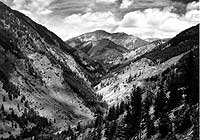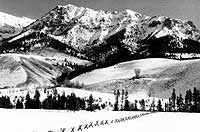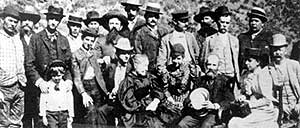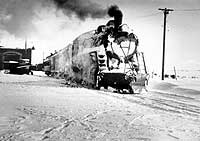

|
Page
170
|
 |
| Midsummer view up Trail Creek to the Pioneer Mountains, north of Sun Valley, (July, 1987). The Trail Creek road snakes up the southeast side of the canyon. |
 |
| West face of the Boulder Mountains, looking northwest from Idaho Highway 75, (February, 1987). Glacial moraines cover the low hills in the foreground. Eocene granite forms the low cliffs on the mountains, with Eocene dacite porphyry and Paleozoic sedimentary rocks above. The mountains are uplifted along a normal fault that bounds the east side of the Wood River Valley. |
The first discoveries in the Wood River area were in May 1879, when David Ketchum found a few small lead-silver prospects near Galena Summit. The Queen of the Hills west of Bellevue was discovered in July of that year. Ketchum, Bellevue, and Hailey were settled in 1880. Smelters were built in Hailey and Ketchum in 1881, and Idaho's first electric light system and one of Idaho's first telephone systems were installed in Hailey in 1882. Investor capital poured into the area from St. Louis and Philadelphia. A branch of the Oregon Short Line reached Hailey in 1883 and Ketchum in 1884. Production from the Wood River mines was over $2 million a year from 1885 to 1887.
But the price of silver was falling and labor troubles developed. The output decreased sharply in 1888 and nearly stopped in 1892, with the collapse of the price of silver. Ketchum was nearly abandoned.
Mining was by no means finished as the Triumph mine southeast of Ketchum produced about $28 million between 1936 and 1957. Now in 1993, it is an Environmental protection agency "Super Fund Site." Ore was brought down from the mine to the Ketchum branch of the Union Pacific on an overhead tramway to Zinc Spur siding near present-day Ketchum. The Minnie Moore Mine was in active use until 1970. The entire production of the Wood River mines is over $62 million.
 |
 |
|
(left) Photograph at left was taken at Ketchum, Idaho in the 1880s during the Wood River Valley mining boom. The Oregon Short Line had just reached the Wood River Valley and prosperity abounded. The bearded man holding his hat is Jay Gould, financier of the OSL. The older woman holding her hands together to the left of Gould is his wife. The woman in the polka dot dress in unidentified. Minnie Howard Collection, Idaho State University. (right) Passenger train just into the Shoshone Shops after a snowstorm on the Hill City (Fairfield) Branch about 1930. Arthur Peterson collection, Bannock County Historical Museum. |
|